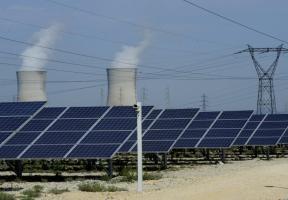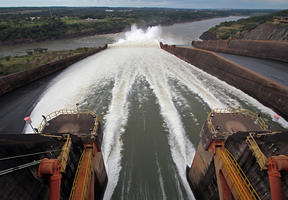Greenhouse Gas Emissions in France
10 min read
France is one of the European Union’s best performers in terms of emissions. This is attributable chiefly to the establishment more than 40 years ago of its extensive nuclear capacity, which ensures can be generated with emissions (CO2). Europe itself is a global region where emissions have fallen sharply since 1990, but with an increase in 2017.

© <br>ERIC FEFERBERG / AFP - France organized climate talks in December 2017, under the One Planet Summit banner. It was attended by 50 world leaders.
France alone emitted the equivalent of 457 million metric tons of CO2 in 2015 (457 Mt CO2e)1. The “carbon footprint,” which includes emissions related to the production and transportation of imported goods, particularly from Asia, was much higher (678 Mt CO2e).
In 2015, each French national emitted an average of 5.1 metric tons of CO2, based solely on activities within the country, while British and German citizens emitted 6.2 and 9.6 metric tons each. Belgians, the Dutch, Spaniards and Italians emitted more per individual than their French neighbors. The E.U. average was 6.8 metric tons.
By way of comparison, average annual CO2 emissions per capita are 4.9 metric tons worldwide, covering a very wide range: 16.1 metric tons per individual in the United States, 7.8 in China, 1.9 in India and 0.9 for residents of sub-Saharan Africa.
A Steady Downward Trend
As is the case throughout Europe, GHG emissions have declined significantly in France over the past 25 years. The reduction over the 1990-2015 period was 16.4% for France, with a 15‑year period of near stability followed by a significant decline over the last ten years.
However, the downward trend has stopped since 2015. According to the latest European estimates3, CO2 emissions attributable to energy consumption increased by 1.8% year on year in the European Union in 2017. The phenomenon is not confined to France and Europe. It has been seen across the world for two years running.
If confirmed, the trend could compromise the objectives contained in France’s "national low‑carbon strategy"3,which aims to achieve a 40% reduction by 2030 compared with 1990. From a longer-term perspective, France hopes to achieve a 75% reduction in emissions compared with pre-industrial levels (known as “factor 4”) by 2050.
The increase stems from several factors:
- Fluctuations in economic growth have an impact on emissions. Periods of growth are reflected in higher consumption, while downturns result in lower emissions. The decline in emissions from 2008 to 2015 was attributable largely to the global economic slowdown, while the resumption of the upward trend seen in 2016 may reflect the European and global economic recovery.
- Many temporary factors affect emissions. Weather conditions, depending on whether winters are harsh or mild, affect emissions from the residential sector. Low oil prices encourage consumption. Maintenance of nuclear reactors may also have a more or less pronounced impact on the network’s generating capacity.
Signals from one year to the next should not be over-interpreted. Long-term trends are a more reliable indicator.
Emissions by Sector
The sector with the highest emissions in France is transportation (29%), followed by the residential and tertiary sectors (16.5%)4. The manufacturing industry and construction contribute 11%, and the energy sector 9.2%, a figure well below the European average (28% of emissions), thanks to the large proportion of nuclear generation in France. This is why France’s electricity sector emits so little CO2: 7% of total emissions, only a quarter of the European average.
In France, the energy industry is set to keep the same share of total emissions in the coming decade. While the manufacturing industry will be called upon to continue its efforts, the focus will be on the transportation and residential-tertiary sectors. France will need to reduce transportation-related emissions by 30% and residential-tertiary emissions by more than 50% if it wishes to meet its 2030 target.
Sources:
- “CO2equivalent”: emissions of CO2itself amounted to 336.6 Mt, ahead of methane (CH4) with 58.9 Mt and nitrous oxide (NH4) with 41.3 Mt. It should also be noted that GHG emissions stood at just 421 MtCO2e when including land use, land use change and forestry (LULUCF). LULUCF emissions are negative, in the E.U. as well as in France, thanks to forest growth.
- Eurostat
- Monitoring of the low-carbon strategy (in French only)
- Key climate figures (in French only)






















